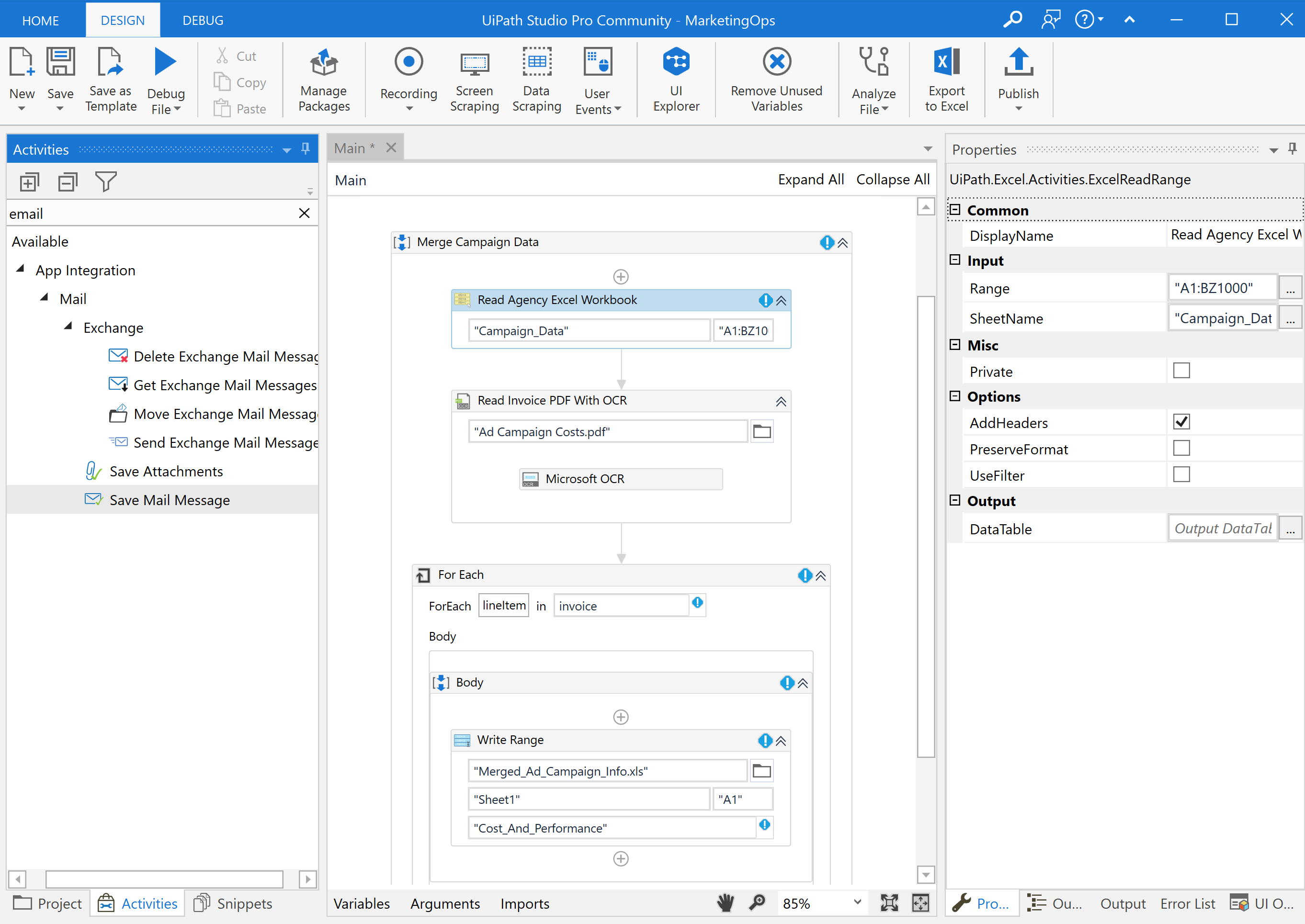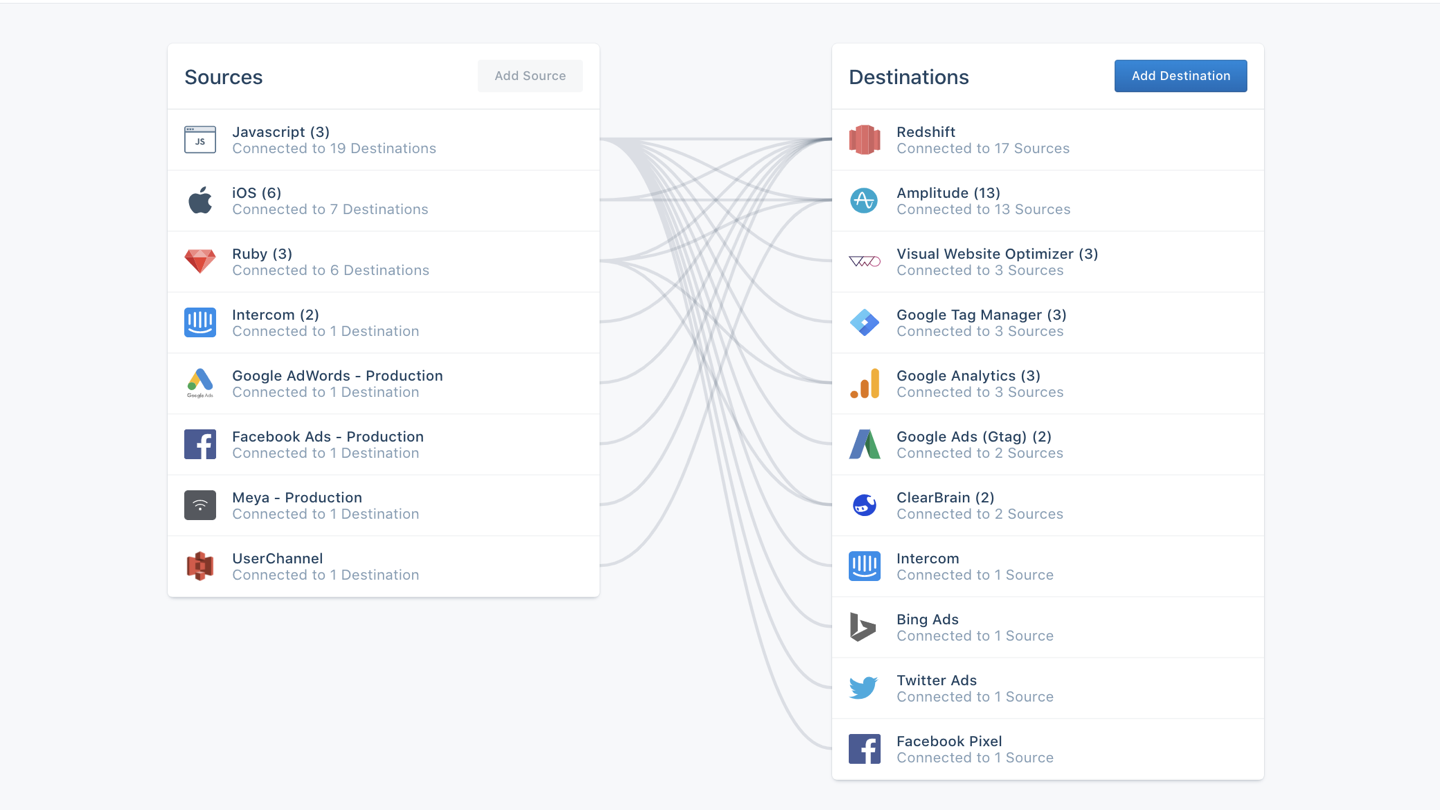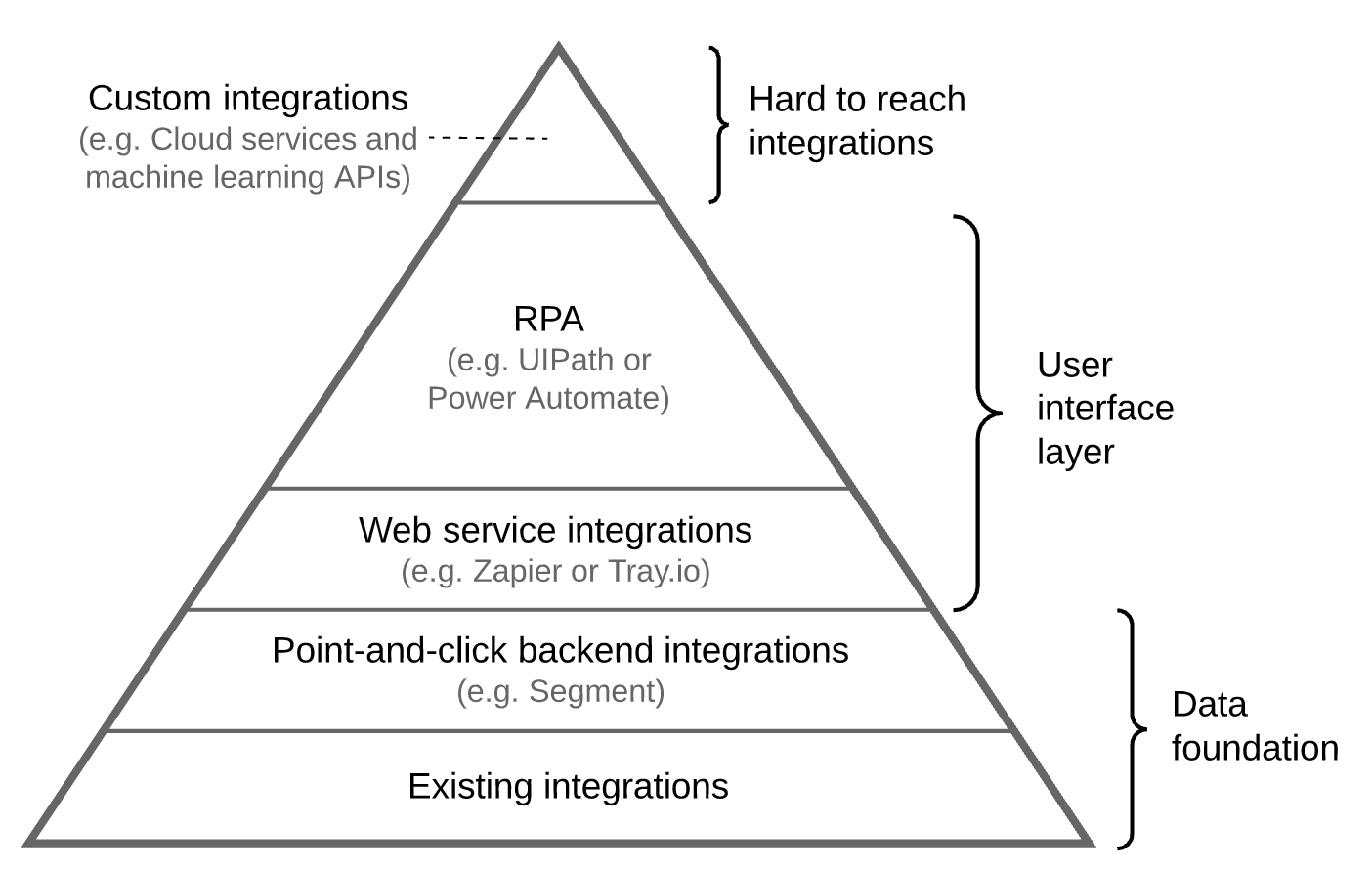
COVID-19 has created a business crisis that, paradoxically, can serve as a positive catalyst for marketers. The urgent need for both revenue growth and cost reduction provides a strong incentive for companies to unblock latent ROI by making changes that have historically been politically unpalatable. This starts with dismantling departmental silos that have long impeded growth initiatives aimed at unifying the customer experience. It also includes the rapid adoption of new technologies that can provide quick, direct ROI, like automation platforms. No/low-code automation technologies like Robotic Process Automation (RPA) and SaaS integration platforms like Segment can significantly streamline process-heavy marketing operations workflows. Marketing orgs that tear down silos and automate processes will be able to do more marketing with a smaller team while improving performance through better targeting. A win-win-win.
In this article, we’ll walk through some real-world patterns and technologies that illustrate how no/low-code automation can rapidly move the needle on reducing waste and improving marketing performance. But first we’ll answer a key foundational question: Why tackle the automation of marketing ops now?
Why automating marketing operations now is an imperative
There are three reasons why today is the right time to start automating marketing ops. First, the cost of automation has dropped significantly, creating an opening for companies of all sizes to start automating key business processes. In the book Prediction Machines, Ajay Agrawal, Joshua Gains and Avi Goldfarb argue that when the cost of a technology drops low enough for ubiquitous consumption, the economics hit a tipping point, spurring transformation. Automation technology is now approaching that inflection point. In the past, automation required large development teams to build custom integrations to connect disparate applications. In contrast, today there are dozens of mature products on the market that enable rapid automation through point-and-click tools and pre-built connectors.
The second reason why automation is imperative today is that marketers will soon be asked to do more with less. According to Ewan McIntyre, a VP Analyst at Gartner: “Marketing organizations are ill-prepared for COVID-19’s impact on the global economy and consumer sentiment, and this crisis will only exacerbate the budget strain we saw developing in 2019.” He goes on to predict that there will be significant budget cuts as a result of the coronavirus: “We expect that COVID-19 will mark the inflection point in which marketing budgets begin to significantly decline. It is critical that marketing leaders take action now to help mitigate the inevitable risks to those budgets” (Immediate Actions for CMOs Amid COVID-19 Related Budget Cuts, Gartner, April 2020). Despite the critical need for revenue, marketers won’t be spared the budget ax. Out-of-the-box thinking and proactive measures can help mitigate the impact of budget cuts, and will be well-received by anxious finance teams.
The third reason why now is the ideal time for automation is that an economic crisis can serve as a common foe to unify fragmented and misaligned departments. This is important because the biggest barrier to marketing transformation is not the technology itself (technology has long surpassed companies’ ability to absorb it), but rather, companies’ ability to work across departments to solve substantive problems. Most meaty business problems today exist at the intersection of multiple organizational units. But when business is good, it’s easier to ignore these opportunities than it is to spend the political capital required to tackle them. An existential crisis flips this dynamic on its head. Faced with an uncertain future, departments are incentivized to band together to survive. For marketing, this means the possibility of finally gaining alignment with MarTech, IT, brand marketing, channel marketing and the business units themselves. Smart marketers won’t squander this opportunity.
Marketing is ripe for automation
Marketing has evolved significantly over the last several years. MarTech tools have matured, data is more accessible, and the customer experience is more targeted. Yet, advances in marketing technology have not simplified the job of marketing operations. Quite the opposite. More marketing channels means more data to wrangle. Multiple platforms require multiple interfaces to learn. Additional content yields additional assets to manage. So, while improvements in marketing technology have increased marketing performance, they’ve done so at the expense of complexity. The unspoken truth in most marketing organizations is that, despite all the shiny new MarTech tools, the duct tape that holds the marketing machine together is a combination of spreadsheets, Word docs, email and digital elbow grease.
It may seem ironic that desktop productivity software created decades ago remains a core component of a modern, cloud-based marketing stack, but it’s simply a manifestation of the “last mile” problem. This term comes from the telco industry, which historically faced challenges getting better/faster telecommunications lines from neighborhood hubs to individual homes. Although newer technology could easily be deployed within the core network, laying the last mile of cable to each home proved to be a difficult challenge. In a similar vein, the core of the MarTech stack includes a degree of integration, but it doesn’t extend all the way to the desktop. In order to operate, humans still need to export files, switch between applications, cut-and-paste content, and stitch together data using VLOOKUP formulas and Excel hacks. To most, solving the last mile problem for marketing seems like an insurmountable goal—few even try. As a result, marketers continue to waste vast amounts of time performing rote, repetitive tasks simply to move information between systems. Fortunately, there is a better way.
RPA solves the last mile problem for marketing
Robotic Process Automation has been around for over a decade, but it’s still not widely known. In a nutshell, RPA gives semi-technical users the ability to create super macros that operate across legacy systems, desktop productivity software, and SaaS applications. It’s a clever but powerful way to handle integration. Rather than tackling automation on the backend via API-to-API integrations (which requires custom software development), RPA achieves automation through the frontend by allowing users to record and replay clicks and keystrokes across different applications. RPA platforms like UIPath and Microsoft Power Automate also give users the ability to program more complex automations through point-and-click configuration, thus minimizing/eliminating the need to write custom code.
 UIPath workflow designer
UIPath workflow designer
RPA solves the last mile problem for marketers by working with—rather than around—user interfaces, mimicking what people are already doing on their desktop. This is a much shorter path to automation than waiting for IT to complete backend API integrations. And even if IT had the bandwidth to connect all the MarTech systems, the marketing ecosystem is changing constantly. New channels and platforms are popping up all the time. To remain Agile, marketers need a way to quickly add new integrations and update existing ones, without relying on IT. This is why Daniel Dines, the CEO and founder of UIPath, envisions a future where every person has a bot. Imagine the productivity and happiness of a marketing team where every team member has their own RPA bot, tailored to their specific job function, that performs repetitive tasks on their behalf. Who wouldn’t want to be part of a team like that?
SaaS integration tools play a key role too
But RPA is not the only no/low-code integration game in town. There are other integration technologies that can augment an RPA-led automaton strategy. Segment is a great example. Segment is a marketer-oriented platform designed to simplify data integration between MarTech products and cloud services. Segment has hundreds of pre-built connectors for email service providers, paid media vendors, CRM tools, analytics platforms and cloud providers. This allows semi-technical users to setup backend API-to-API integrations through point-and-click configuration tools. For example, in just a few hours, you can configure Segment to ingest Google Ads, Google Analytics and Salesforce data into a cloud-based data warehouse, a project that would have previously taken a team of data engineers months to complete.
Since backend integrations are required for managing large datasets, platforms like Segment make a natural complement to frontend-focused integration technologies like RPA. Segment also includes data governance tools, privacy safeguards, and a Customer Data Platform that unifies customer data into a single profile. So, although getting started with Segment is simple, the capabilities it provides are powerful.
 Segment screen shot showing backend integrations across platforms
Segment screen shot showing backend integrations across platforms
In addition to Segment, there are several web service integration products on the market that can also support a marketing automation strategy. These services fit somewhere in the middle between frontend integration tools like RPA and backend integration platforms like Segment. Zapier is a popular low-cost integration tool the enables simple automated workflows across 2,000 different SaaS apps. For example, you could setup a Zapier workflow (called a “Zap”) that saves social media mentions to a shared spreadsheet, determines which ones have a negative sentiment and then notifies a social media manager via email or Slack. Tray.io provides similar services, but with a more enterprise-focused product offering.
Use a tiered approach to automate marketing ops
With so many different automation options available, the question isn’t if automating marketing ops is possible, but rather how.
The first step is getting crisp on uses cases. Start by cataloging all the processes and workflows that are possible candidates for automation. Then determine which ones are likely to yield the most time savings if automated. This will help you to prioritize your use cases, ensuring that the highest ROI processes are automated first. If the scope of your automation initiative is significant, consider using a technique like process mining, which leverages software that reads log data to quantify the time/cost of workflows and processes.
Next, map out an automation game plan using all the integration tools at your disposal. The automation plan should be designed in layers. Start with the foundational layer, which includes core systems and larger data sets. For these systems, leverage existing integrations and backend-focused integration platforms like Segment. The next tier is the user interface layer. This layer automates the processes that are currently being performed on the desktop. Use a combination of web service integration tools (e.g. Zapier or Tray.io) and RPA for this layer. Web services integration tools are easier to setup, but they lack the power and flexibility of RPA. The final layer includes custom integrations. Use these sparingly as they are the costliest option. However, there will almost certainly be some use cases that can’t be completed with no/low-code tools alone, so some custom integration will likely be required.

Finally, approach the automation implementation incrementally. Rather than trying to automate everything at once, tackle processes one by one, in bite-sized chunks. This ensures that the benefits of automation are realized early, and that the learnings from initial automations can be applied to later efforts. This approach is consistent with the Agile methodology adopted by modern marketing organizations.
Use automation to think big and drive revenue
Given the breadth of tools and technologies available today, the time is right to start automating marketing operations. By leveraging a no/low-code approach, significant cost savings are possible without a massive upfront investment. But the ROI gained from cost reduction is just the first act. The bigger opportunity is to move beyond the automation of current state processes and identify new revenue-generating capabilities that can be unlocked through automation. Marketers should start asking the question: How would I approach marketing differently if I had an army of bots that freed me from the operational constraints that tie my hands today?
For example, automation could be used to enable more targeted—and higher-performing—marketing campaigns. An RPA bot could be built to create hundreds of highly targeted, long-tail keyword campaigns by 1) scraping product information from the website, 2) calling machine learning APIs to extract keywords, and 3) automatically creating keyword campaigns in Google Ads. The same bot could automatically pause campaigns when inventory is low or if a campaign performs below a certain threshold.
Bots can also be used to improve collaboration between departments, helping break down silos that impede growth. For example, a bot created by the web analytics team could be programmed to 1) grab campaign IDs from conversion reports in Adobe Analytics, 2) extract campaign metadata directly from the email marketing team’s Email Service Provider platform, and 3) use Slack to send timely performance information to email marketing using their own terms and campaign descriptions. The bot could do the same for paid marketing teams and outside media agencies by tapping directly into their DSPs (Demand Side Platform) and publisher-specific tools.
But by far, the biggest revenue impact from automation is the liberation of mind share. Removing rote, repetitive tasks from people’s task lists makes them happier and gives them more time to think and act strategically. Instead of wasting time compiling data, they can now spend more time interpreting it. Rather than fighting with MarTech tools to keep their heads above water, they can master their toolset and use it in completely new ways. And for the CMO, it enables her to transform the marketing team from a group of operations-focused worker bees to a turbo-charged growth engine.
Related Articles:
- The Five Pillars of Modern Marketing: A Modern Marketing Manifesto for building a data-rich, customer-centered marketing engine
- What is a Customer Data Platform (CDP) in plain English? Vendor-neutral answers to the top 10 most commonly asked questions about CDPs
- AI-Enabled Personalization is Easier Than You Think: Four ways to start incorporating AI and personalization into your marketing today